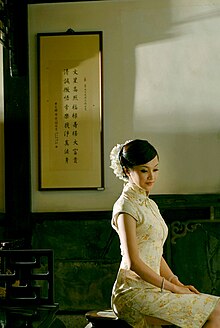
Back Dṳ̆ng-huà mìng-cŭk CDO چانگوا مینزو Persian Zhonghua minzu French Zhonghua minzu ID Zhonghua minzu Italian 中華民族 Japanese 중화민족 Korean Zhonghua minzu Malay Zhonghua minzu Portuguese Chunwa runa Quechua
This article needs additional citations for verification. (July 2024) |
This article is missing information about "revival" / "rejuvenation" (复兴) of the Chinese nation. (January 2021) |
| Zhonghua minzu | |||||||||||||||||||||||||||||||||||||||
|---|---|---|---|---|---|---|---|---|---|---|---|---|---|---|---|---|---|---|---|---|---|---|---|---|---|---|---|---|---|---|---|---|---|---|---|---|---|---|---|
| Traditional Chinese | 中華民族 | ||||||||||||||||||||||||||||||||||||||
| Simplified Chinese | 中华民族 | ||||||||||||||||||||||||||||||||||||||
| Literal meaning | Chinese nation[note 1] | ||||||||||||||||||||||||||||||||||||||
| |||||||||||||||||||||||||||||||||||||||
| Part of a series on |
| Names of China |
|---|
|
Zhonghua minzu (Chinese: 中華民族; pinyin: Zhōnghuá mínzú; Wade–Giles: Chung1-hua2 min2-tsu2) is a political term in modern Chinese nationalism related to the concepts of nation-building, ethnicity, and race in the Chinese nationality.[4][5][6][7][8]
Zhonghua minzu was established during the early Beiyang (1912–1927) periods to include Han people and four major non-Han ethnic groups: the Manchus, Mongols, Hui, and Tibetans,[9][10] under the notion of a republic of five races (Wǔzú gònghé). Conversely, Sun Yat-sen and the Kuomintang (KMT) envisioned it as a unified composite of Han and non-Han people.[11][non-primary source needed] It is slightly different from the word Hanzu (Chinese: 漢族; pinyin: Hànzú; Wade–Giles: Han4-tsu2), a word is only used to refer to the Han Chinese.
Zhonghua minzu was initially rejected in the People's Republic of China (PRC) but resurrected after the death of Mao Zedong to include Han Chinese alongside 55 other ethnic groups as a collective Chinese family.[4][7] Since the late 1980s, the most fundamental change of the PRC's nationalities and minorities policies is the renaming from Zhongguo renmin (中国人民; 'the Chinese people') to Zhonghua minzu (中华民族; 'the Chinese nation'), signalling a shift away from a multinational communist people's statehood of China to one multi-ethnic Chinese nation state with one single Chinese national identity.[8]

- ^ State and Society in 21st Century China: Crisis, Contention and Legitimation. Psychology Press. 2004. p. 180. ISBN 978-0-415-33204-0.
... however, the CCP's nationalist claims are increasingly falling on deaf ears. Popular nationalists like Jin Hui now speak regularly of the "Motherland" (zuguo) and the "Chinese race" (Zhonghua minzu) - without reference to the Party. And they care so deeply
- ^ Anderlini, Jamil (21 June 2017). "The dark side of China's national renewal". Financial Times. Retrieved 9 March 2021.
- ^ David Tobin (October 2022). Securing China's Northwest Frontier: Identity and Insecurity in Xinjiang. Cambridge University Press. p. 235. ISBN 978-1-108-48840-2.
Repeated use of what should now be translated as 'Chinese race, (Zhonghua Minzu 中华民族), alongside omission of ethnic minorities in official narratives ...
- ^ a b Cite error: The named reference
LandisAlbert2012was invoked but never defined (see the help page). - ^ Cite error: The named reference
Zhao2000was invoked but never defined (see the help page). - ^ Zhou, Wenjiu; Zhang (2007). 关于"中华民族是一个"学术论辩的考察 [On the academic argument that "the Chinese nation is one"]. Minzu Yanjiu (in Chinese). 3: 20–29. Archived from the original on 29 October 2019. Retrieved 29 October 2019 – via d.old.wanfangdata.com.cn/Periodical/mzyj200703003.
- ^ a b Cite error: The named reference
Lawrance2004was invoked but never defined (see the help page). - ^ a b Cite error: The named reference
BloxhamMoses2010was invoked but never defined (see the help page). - ^ Cite error: The named reference
Fitzgerald1995was invoked but never defined (see the help page). - ^ Blum, Susan Debra; Jensen, Lionel M. (2002). China Off Center: Mapping the Margins of the Middle Kingdom. University of Hawaiʻi Press. pp. 170–. ISBN 978-0-8248-2577-5. Retrieved 13 October 2016.
- ^ Sun, Yat-sen (1994) [Speech from 1919]. "3.5 The Three Principles of the People [San-min chu-i]". In Wei, Julie Lee; Myers, Ramon H.; Gillin, Donald G. (eds.). Prescriptions for saving China: Selected writings of Sun Yat-sen. Translated by Wei, Julie Lee; Zen, E-su; Chao, Linda. Stanford, Calif.: Hoover Institution Press. pp. 223–225. ISBN 0-8179-9281-2.
Cite error: There are <ref group=note> tags on this page, but the references will not show without a {{reflist|group=note}} template (see the help page).
